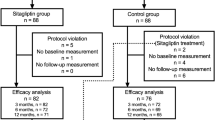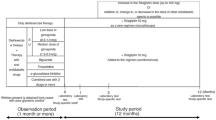Abstract
Background and Objectives: Telmisartan has been reported to have beneficial effects on insulin resistance and lipid profiles by acting as a peroxisome proliferator-activated receptor-γ (PPARγ) agonist. In this study we investigated the relationship between telmisartan dose and glycaemic control in Japanese subjects with type 2 diabetes mellitus and hypertension.
Methods: Patients (n = 263) who were prescribed telmisartan 20, 40 or 80 mg/day at our clinic were retrospectively identified from our clinical database. Only patients without changes in their treatments for diabetes and hypertension for 6 months after starting telmisartan were included in this study. Glycosylated haemoglobin A1c (HbA1c) levels were measured at 0, 3 and 6 months after starting telmisartan.
Results: At 3 and 6 months after starting telmisartan, HbA1c levels were significantly decreased in patients treated with telmisartan 40 or 80 mg/day but not in patients treated with telmisartan 20 mg/day (mean ± standard error change at 6 months: −0.29 ± 0.10%, p<0.001; −0.48 ± 0.15%, p<0.001; and −0.03 ± 0.10%, p = 0.33; respectively). When patients were classified into two groups by telmisartan dose (20 vs ≥40 mg/day), there was no significant correlation between baseline HbA1c and change in HbA1c levels over time in the 20 mg/day group. However, in patients treated with ≥40 mg/day of telmisartan, baseline HbA1c was negatively correlated with the change in HbA1c at 6 months. Multiple regression analysis confirmed that baseline HbA1c and telmisartan dose were the predictive factors.
Conclusion: Our results suggest that telmisartan influences glycaemic control in a dose-dependent manner; doses ≥40 mg/day may be needed to improve glycaemic control. Our data also suggest that patients with higher baseline HbA1c may experience greater improvements in glycaemic control with telmisartan.



Similar content being viewed by others
References
Yusuf S, Gerstein H, Hoogwerf B, et al. Ramipril and the development of diabetes. JAMA 2001 Oct 17; 286(15): 1882–5
Lindholm LH, Ibsen H, Borch-Johnsen K, et al. Risk of new-onset diabetes in the Losartan Intervention For End-point reduction in hypertension study. J Hypertens 2002 Sep; 20(9): 1879–86
Yusuf S, Ostergren JB, Gerstein HC, et al. Effects of can-desartan on the development of a new diagnosis of diabetes mellitus in patients with heart failure. Circulation 2005 Oct 25; 112(7): 48–53
Kjeldsen SE, Julius S, Mancia G, et al. Effects of valsartan compared to amlodipine on preventing type 2 diabetes in high-risk hypertensive patients: the VALUE trial. J Hypertens 2006 Jul; 24(7): 1405–12
McMurray JJ, Holman RR, Haffner SM, et al. Effect of valsartan on the incidence of diabetes and cardiovascular events. N Engl J Med 2010 Apr 22; 362(16): 1477–90
Benson SC, Pershadsingh HA, Ho CI, et al. Identification of telmisartan as a unique angiotensin II receptor antagonist with selective PPARgamma-modulating activity. Hypertension 2004 May; 43(5): 993–1002
Kurtz TW. Treating the metabolic syndrome: telmisartan as a peroxisome proliferator-activated receptor-gamma activator. Acta Diabetol 2005 Apr; 42 Suppl. 1: S9–16
Kurtz TW, Pravenec M. Antidiabetic mechanisms of angiotensin-converting enzyme inhibitors and angiotensin II receptor antagonists: beyond the renin-angiotensin system. J Hypertens 2004 Dec; 22(12): 2253–61
Schupp M, Janke J, Clasen R, et al. Angiotensin type 1 receptor blockers induce peroxisome proliferator-activated receptor-gamma activity. Circulation 2004 May 4; 109(17): 2054–7
Clasen R, Schupp M, Foryst-Ludwig A, et al. PPARgamma-activating angiotensin type-1 receptor blockers induce adiponectin. Hypertension 2005 Jul; 46(1): 137–43
Mori Y, Tanaka T, Matsuura K, et al. Influence of telmisartan on insulin response after glucose loading in obese patients with hypertension: ARB trial of hypertension in obese patients with hyperinsulinemia assessed by oral glucose tolerance test (ATHLETE). Adv Ther 2011 Aug; 28(8): 698–706
Vitale C, Mercuro G, Castiglioni C, et al. Metabolic effect of telmisartan and losartan in hypertensive patients with metabolic syndrome. Cardiovasc Diabetol 2005 May 15; 4: 6
Honjo S, Nishi Y, Wada Y, et al. Possible beneficial effect of telmisartan on glycemic control in diabetic subjects [letter]. Diabetes Care 2004 Apr; 27(4): 1015
Negro R, Hassan H. The effects of telmisartan and amlodipine on metabolic parameters and blood pressure in type 2 diabetic, hypertensive patients. J Renin Angiotensin Aldosterone Syst. 2006 Dec; 7(4): 243–6
Derosa G, Fogari E, D’Angelo A, et al. Metabolic effects of telmisartan and irbesartan in type 2 diabetic patients with metabolic syndrome treated with rosiglitazone. J Clin Pharm Ther 2007 Jun; 32(3): 261–8
Derosa G, Cicero AF, D’Angelo A, et al. Telmisartan and irbesartan therapy in type 2 diabetic patients treated with rosiglitazone: effects on insulin-resistance, leptin and tumor necrosis factor-alpha. Hypertens Res 2006 Nov; 29(11): 849–56
Yamana A, Arita M, Furuta M, et al. The angiotensin II receptor blocker telmisartan improves insulin resistance and has beneficial effects in hypertensive patients with type 2 diabetes and poor glycemic control. Diabetes Res Clin Pract 2008 Oct; 82(1): 127–31
Mori Y, Itoh Y, Tajima N. Telmisartan improves lipid metabolism and adiponectin production but does not affect glycemic control in hypertensive patients with type 2 diabetes. Adv Ther 2007 Jan–Feb; 24(1): 146–53
Nakayama S, Watada H, Mita T, et al. Comparison of effects of olmesartan and telmisartan on blood pressure and metabolic parameters in Japanese early-stage type-2 diabetics with hypertension. Hypertens Res 2008 Jan; 31(1): 7–13
Acknowledgements
Kitano Hospital received research grants from MSD, Roche, Novo Nordisk Pharma and Astellas Pharma. Y.H. designed the study, analysed and interpreted the data, and drafted the manuscript. S.H., Y.K., H.I., K.M., Y.I., K.N. and Y.W. contributed to the conduct of the study and to accumulation of the data. K.F. and H.T. helped to draft the manuscript. H.K. critically revised the manuscript for important intellectual content. None of the authors report any conflicts of interest that are directly relevant to this study.
Author information
Authors and Affiliations
Corresponding author
Rights and permissions
About this article
Cite this article
Hamamoto, Y., Honjo, S., Kawasaki, Y. et al. Relationship between Telmisartan Dose and Glycaemic Control in Japanese Patients with Type 2 Diabetes Mellitus and Hypertension. Clin Drug Investig 32, 577–582 (2012). https://doi.org/10.1007/BF03261912
Published:
Issue Date:
DOI: https://doi.org/10.1007/BF03261912




